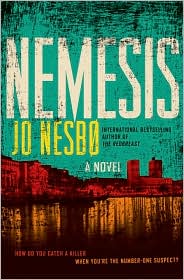“A good manipulator can make you believe that the edge of a 100-kroner note is the edge of a knife.”
 More like a fiendish sudoku puzzle than a traditional police procedural, this blockbuster novel, set in Oslo, challenges alcoholic Inspector Harry Hole to find solutions to four cold-blooded murders, which may or may not be related. A “square peg” in the police department, Hole does jot hesitate to do things his own way, often infuriating his peers while still inspiring (sometimes grudging) respect for his honesty.
More like a fiendish sudoku puzzle than a traditional police procedural, this blockbuster novel, set in Oslo, challenges alcoholic Inspector Harry Hole to find solutions to four cold-blooded murders, which may or may not be related. A “square peg” in the police department, Hole does jot hesitate to do things his own way, often infuriating his peers while still inspiring (sometimes grudging) respect for his honesty.
A bank robbery in which a gunman executes his female hostage because the bank manager exceeds twenty-five seconds to fill a bag with money is just the start of the non-stop action. As Harry Hole investigates the similarities between this robbery and the stunning earlier robberies by Raskol Baxhet, a gypsy now incarcerated, the reader is jerked every which-way, his/her perceptions constantly changed as new information emerges about the characters and the past.

When the video of the bank robbery/murder becomes available, Beate Lonn begins working the case with Harry. Beate is one of only ten people in the world who can remember every face she has ever seen, and Harry becomes her mentor in the department. Both Harry and Beate are grieving—he for the loss of Ellen Gjelten, his partner and friend, murdered while investigating arms-trafficking, and Beate for the loss of her father, a police officer also murdered. Questions remain about both murders.
When Harry, one night, accepts a dinner invitation from a former lover, “for old times’ sake,” he becomes involved in yet another case–his own. Awakening the morning after their date, he has absolutely no memory of anything that happened that evening, but Anna has been brutally murdered, and Harry’s cell phone is missing.
As Harry and his ri vals within the police department work to solve the most recent murders, the author considers the psychology of the characters as much as their actions, often switching points of view between paragraphs and scenes. The meticulously constructed plot moves at breakneck pace, and as Nesbo draws in new characters, each of whom has a past to be investigated, he juggles bits and pieces of information—and surprises—which change direction and focus.
vals within the police department work to solve the most recent murders, the author considers the psychology of the characters as much as their actions, often switching points of view between paragraphs and scenes. The meticulously constructed plot moves at breakneck pace, and as Nesbo draws in new characters, each of whom has a past to be investigated, he juggles bits and pieces of information—and surprises—which change direction and focus.
The cases become more intertwined and more complex, and “Case Solved” proves time and again to be an illusion. The action moves from Oslo to Brazil and back, from mainstream neighborhoods to gypsy caravans and the Oslo jail, from the police department to the lonely citizens they serve, and fro Harry to his long-time love, who is in Russia suing for custody of her son.
The reader’s interest grows in Harry Hole, Beate Lonn, and several other characters, and Harry’s relationship with jailed Raskol Baxhet, the gypsy robber, is particularly interesting, as he and Baxhet, a master manipulator, alternately despise and respect one another. Ultimately the reader agrees with the author that “A good manipulator can make you believe that the edge of a 100-kroner note is the edge of a knife.” Author Nesbo proves to the greatest manipulator of all.
Note: In the UK, the (London) Times has declared: “Jo Nesbo is not just a good Norwegian author; he’s very near the top of the Nordic crime writers’ league.”
Also reviewed here (See Wikipedia for the order of release): Nesbo’s THE REDBREAST, THE DEVIL’S STAR, THE REDEEMER, THE SNOWMAN, HEADHUNTERS, THE LEOPARD, PHANTOM, THE BAT, POLICE COCKROACHES (1998), THE SON (2014), BLOOD ON SNOW (2015), MIDNIGHT SUN (2016), THE THIRST (2017), KNIFE (2019)
Credits: The author’s photo comes from http://www.independent.co.uk
The photo of the police car outside a local precinct station is from http://www.police-car-photos.com

